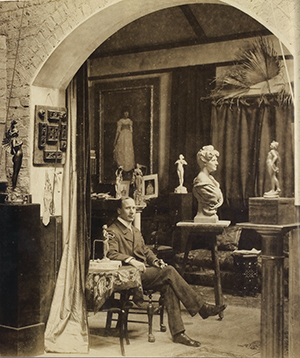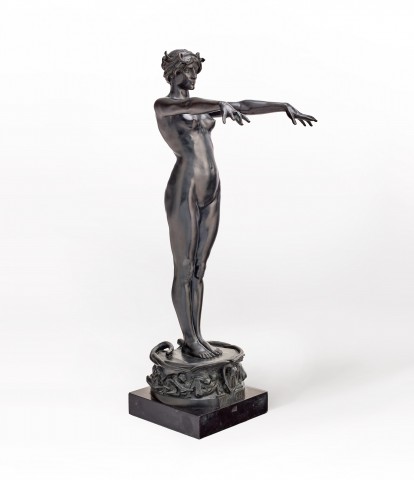CIRCE, c.1902 – 04
BERTRAM MACKENNAL
bronze
57.0 cm height
inscribed at base: KIP KH
signed at base: B MACKENNAL
Dr J.J.C. Bradfield, Sydney, a gift from the artist, c. 1927
Thence by descent
Edith Bradfield, Sydney
Dr Stanley G. Bradfield, Sydney, a gift from the above c.1945
Thence by descent
Enid Bradfield, Sydney
Thence by descent
Family collection, Canberra
The Royal Glasgow Institute of Fine Arts, Scotland, 1905, cat. 854 (another example)
The Franco-British Exhibition, London, UK, 1908, cat. 1305 (another example)
International Fine Arts Exhibition, Rome, 1911 (another example)
The Royal Glasgow Institute of Fine Arts, Scotland, 1918, cat. 45 (another example)
Exhibition of bronzes by Sir Bertram Mackennal K.CV.O., R.A., Macquarie Galleries, Sydney, 7 – 20 October 1926, cat. 10 (another example)
Memorial exhibition of statuettes by the Late Sir Bertram Mackennal, K.C.V.O, Fine Arts Society Gallery, Melbourne, May 1932 (another example)
Commemorative exhibition of works by late members, Winter Exhibition, Royal Academy, London, 7 January – 11 March 1933, cat. 98 (another example, lent by Lady Mackennal)
British Sculpture 1850 – 1914, The Fine Art Society, London, 30 September – 30 October 1968, cat. 106 (another example)
Spring exhibition. Recent Acquisitions, Joseph Brown Gallery, Melbourne, 18 – 29 October 1976, cat. 33 (another example)
Early Australian sculpture, from its beginnings up to circa 1920, Ballarat Fine Art Gallery, Victoria, 15 March 1977, cat. 20 (another example)
Spring exhibition 1979, Joseph Brown Gallery, Melbourne, 17 – 30 October 1979 (another example)
Australian Sculpture 1890 – 1919, Art Gallery of New South Wales, Sydney, 22 January – 22 February 1987 (another example)
Stampede of the Lower Gods: Classical Mythology in Australian Art 1890's-1930's, Art Gallery of New South Wales, Sydney, 19 October – 26 November 1989
Australian Art, Colonial to Contemporary, Deutscher Fine Art, Melbourne, May – June 1995, cat. 1128 (another example)
Reverie, myth, sensuality: sculpture in Britain 1880 – 1910, City Museum and Art Gallery, Stoke-on-Trent, UK, 26 September – 29 November 1992 (another example)
Australian icons: twenty artists from the collection, Art Gallery of New South Wales, Sydney, 4 August – 3 December 2000 (another example)
Exposed: The Victorian Nude, Tate Britain, London, 1 November 2001 – 13 Jan 2002, and touring (another example)
Bertram Mackennal: The Fifth Balnaves Sculpture Project, Art Gallery of New South Wales, Sydney, 17 August – 4 November 2007; National Gallery of Victoria, Melbourne, 30 November 2007 – 24 February 2008 (another example)
Edwardian opulence: British art at the dawn of the twentieth century, Yale Center for British Art, New Haven, USA, 28 February – 2 June 2013 (another example)
Archie Plus, Art Gallery of New South Wales, Sydney, 26 September 2020 – 7 March 2021 (another example)
Spielmann, M. H., British Sculpture and Sculptors of Today, Cassel, London, 1901, p. 134
Moore, W., The Story of Australian Art, vol. 1, Angus & Robertson, Sydney, 1934, p.202 (illus., another example)
Badham, H., A Study of Australian Art, Currawong Publishing, Sydney, 1949, p. 136
Badham, H., A Gallery of Australian Art, Currawong Publishing, Sydney, 1954, pl. 101 (illus. another example)
McCulloch, A., Encyclopedia of Australian Art, Hutchinson, Richmond, 1968, p. 662
Cooper, J., Nineteenth-Century Romantic Bronzes, David and Charles, London, 1975, p. 92
Flower, C., Erotica: Aspects of The Erotic in Australian Art, Sun Books, South Melbourne, 1977, pp. 24 – 25 (illus., another example)
Sturgeon, G., The Development of Australian Sculpture 1788-1975, Thames and Hudson, London, 1978, pp. 64, 65 (illus., another example)
Scarlett, K., Australian Sculptors, Nelson, Melbourne, 1980, p.405
Clark, J., et. al., Golden Summers: Heidelberg and beyond, ICCA, Sydney, 1985, p. 181 (illus. another example)
Thomas, D., (ed.) Creating Australia: 200 years of art 1788-1988, ICCA, Sydney, 1988, p. 129 (illus. another example)
Lane, T., Nineteenth Century Australian Art in the National Gallery of Victoria, NGV, Melbourne, 2003, pp. 116 – 117 (illus. another example)
Edwards, D., et. al., Bertram Mackennal, Art Gallery of New South Wales, Sydney, 2007, pp. 30 (illus. and illus. cover, another example), 31 – 34, 168 – 71, 211 (illus. detail), and catalogue in accompanying CD–ROM
Mendelssohn, J., 'Australian symbolism: the art of dreams', Art & Australia, Sydney, Summer 2012, p. 309
Trumble, A., and Wolk Rager, A. (eds), Edwardian opulence: British art at the dawn of the twentieth century, Yale University Press, New Haven, 2013, cat. 89, pp. 349 (illus., another example), 351, 410
Grishin, S., Australian art: a history, The Miegunyah Press, Victoria, 2013, pl. 17.5, pp. 166, 167 (illus. another example), 548, 564
Bertram Mackennal portrays the sorceress Circe in the moment of casting a spell – awesome, ominous and dangerously all-powerful. Beguiled by the beauty of the sensuous curves and naked body, her pose is confrontational and commanding. Mackennal’s public presentation of his sculpture of Circe was a triumph, bringing him fame and recognition. Exhibited prominently in the Paris Salon (Société des Artistes Français) of 1893, it received the added prestige of being illustrated in the catalogue. Not only were reviews highly favourable, Mackennal also received a mention honorable. Writing in the Revue des Deux Mondes, one French critic observed: ‘The tense, restrained, but triumphant beauty of the sorceress bears itself with a firm and elegant alertness which is free from all trace of vulgarity and all suggestion of the model: no small merit in our opinion at the present day’.1 The English critic, R. Jope-Slade, praised Circe for its ‘remarkable and distinctive individuality’. He continued:
Bertram Mackennal in his London studio, c.1898.jpg

This powerful woman with extended arms and drooping hands, and the serpent-filled tresses of a witch, stands erect, almost rigid in the pride of consciousness of the irresistible supremacy of her nudity; but form and face are devoid of voluptuousness, and her expression is one of scorn for her victims. 2
While the French had taken Circe in their stride, across the Channel at London’s Royal Academy she caused something of a sensation. Keen to show her in the 1894 exhibition, the prudish action of the hanging committee caused more than a sniff of scandal. Prominently displayed, they covered her base with a swathe of red baize to hide the erotic figuring, which Mackennal had described as ‘debased men and women who have drunk of Circe’s wine’.3 It had the opposite effect. Exciting the public’s imagination, it became the talk of the town.
The tale of the ancient goddess Circe is drawn from the pages of Homer’s The Odyssey. Here we learn of her enticements, of turning men into wild beasts and Odysseus’ sailors into swine. Irresistible and all conquering, Circe is the classic femme fatale, a fascination that gripped many of the creative minds of the fin-de- siècle. A memorable oil painting is Circe Invidiosa, painted in 1892 by the English artist J. W. Waterhouse (Art Gallery of South Australia). Favoured by the Symbolists, the femme fatale populated opera, Nikolai Rimsky-Korsakov devoted a symphonic suite to Scheherazade, and Aubrey Beardsley, Richard Strauss and Oscar Wilde produced their own versions of Salome. These powerful figures also reflected contemporary interests in the women’s movement and the rise of feminine equality. 4
As the century drew to a close, subjects from classical mythology grew in popularity, especially among the young Australian artists exhibiting in Paris and London. Rupert Bunny’s Tritons c.1890 (Art Gallery of New South Wales) gained a mention honorable at the Salon of 1890 and is believed to have been purchased by Alfred Felton. Bunny also exhibited Pastoral c.1893 (National Gallery of Australia) in the same 1893 Salon as Mackennal’s Circe. Other notables in that same Salon included John Longstaff’s The Sirens 1892 and Aby Altson’s The Golden Age, 1893 (both in the collection of the National Gallery of Victoria). The latter also received a mention honorable.
The life-sized sculpture of Circe, which Mackennal exhibited in the Paris Salon of 1893 and London’s Royal Academy of 1894, was made of plaster, cast from the clay model. In Paris in 1901 Mackennal had it cast in bronze, the sculpture subsequently being acquired by the National Gallery of Victoria through the Felton Bequest in 1910. In response to the popularity of the work, Mackennal produced an edition of statuettes, of which the work on offer is one, cast in bronze in Paris between 1902 and 1904. Another is in the collection of the Art Gallery of New South Wales, which produced, from the original bronze, a limited edition of 100, hand-cast in bonded bronze powder and polymer resin during 1997-1998. They are inscribed and numbered on the base: ‘B. Mackennal AGNSW …/100 Kip KH’.
At the time of completing Circe in 1893, Mackennal wrote to his Melbourne patron and friend Felix Meyer saying: ‘I feel that I am all in it … I put so much time, money & thought into my Circe, …’.5 Noted for its lively invention and technical excellence, its blend of French and British aesthetics is seamless. Mackennal is seen at his brilliant best in his combination of naturalism and symbolism. Knighted in 1921, internationally he remains today one of Australia’s most successful artists.
When Mackennal made a celebrated visit to Australia in 1926, he was treated like a hero, receiving a number of prestigious commissions. Chief among these came from the State Government of New South Wales to undertake the design and erection of a cenotaph in Sydney’s Martin Place. The work was supervised by the noted engineer Dr John Bradfield (1867-1943), acknowledged as the ‘father’ of modern Sydney through his leading roles on the Sydney Harbour Bridge and other major projects undertaken for the Department of Public Works over many years. Notable for Mackennal’s bronze figures of an Australian soldier and sailor, the Cenotaph was unveiled in February 1929.
Seemingly as a gesture of appreciation arising from their professional association with the Cenotaph, Mackennal gave Bradfield one of his bronze statuettes of Circe, believed to be one of the eight cast between 1902-4. An artist’s gift of one of their works, especially one of their most celebrated, is something very special. This is particularly so for the statuette Circe on offer, distinguished ownership adding prestige, interest of association and value for the prospective collector.
During his Sydney visit of 1926, Mackennal held a solo exhibition of his bronzes at the Macquarie Galleries. Another example of the bronze statuette Circe was included. The exhibition was a sell-out.
1. ‘Les Salons des 1893: la Peinture au Champ du Mars et al sculptures sans les deux salons, Revue des Deux Mondes, vol. 118, July 1893, unpaginated, quoted in Jope-Slade, R., ‘An Australian Quartette’, The Magazine of Art, London, 1895, vol. 18, p. 390
2. Jope-Slade, ibid.
3. Mackennal, B., Table Talk, Melbourne, 29 June 1894, p. 3
4. Lane, T., ‘An Homeric Goddess for The Modern Age: Circe 1893’, in Edwards, D., et al, Bertram Mackennal, Art Gallery of New South Wales, Sydney, 2007, p. 168
5. Mackennal letter to Felix Meyer, 12 April 1893, Felix Meyer papers, quoted in Lane, ibid
DAVID THOMAS
